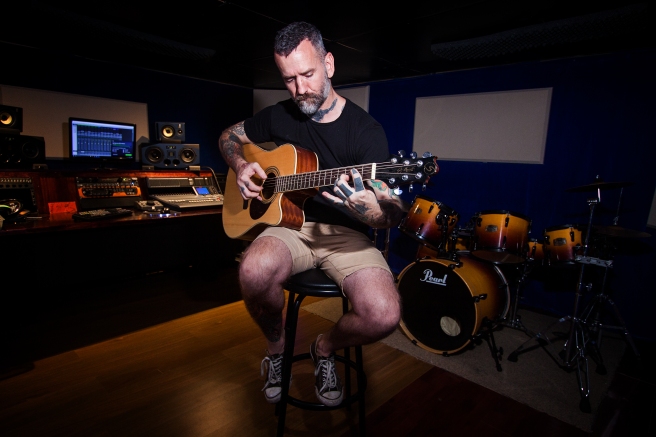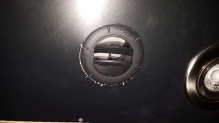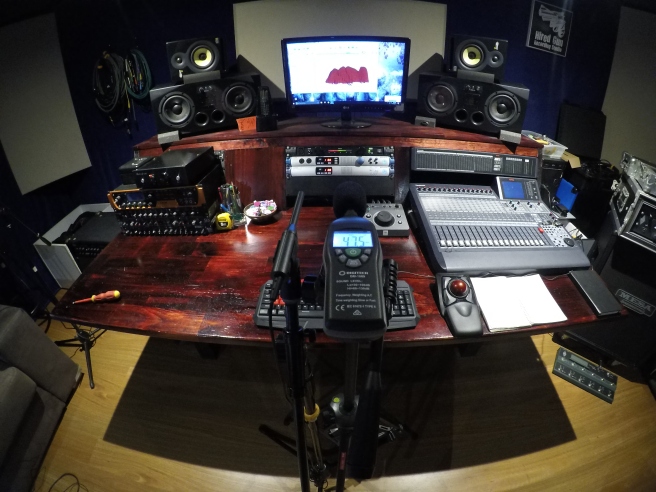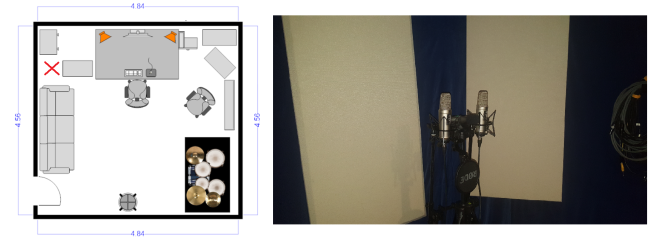Introduction
In this investigation, I will acoustically analyse Hired Gun Recording Studio (HGRS) in order to determine factors that adversely affect sound quality within the room. As an Audio Engineer, it is extremely important that I have a good understanding of the acoustic properties of my audio working space. The properties of a room can drastically absorb and reflect frequencies of the audio that is played within it, changing how sound is perceived. This blog will explore the different aspects that impact audio performance within HGRS.

Inside HGRS

Rehearsing in my studio
Room Purpose
The room is used as an audio manipulation environment, performing engineering tasks such as tracking and mixing audio. It is also used as a rehearsal space for my band, and also for teaching guitar. It is a purpose-built recording studio/rehearsal space that is a free-standing box that I constructed within my double lockup garage.
Room Properties
The dimensions of the room are as follows:
L = 484 cm W = 456 cm H = 200 cm
To apply the bolt ratio, we must convert the height to the value 1 and divide the values for length and width by the same denominator.
L : W : H
484 : 456 : 200
(484/200) : (456/200) : (200/200)
= 2.42 : 2.28 : 1

The ratio for the room does not plot within the dotted line on the chart, therefore, the room does not fit the Bolt Ratio. I overcome this shortfall by artificially changing the width of the room with removable free-standing panels and the position of my sofa.
The floors are polished timber laminate, the walls are covered in stage curtain and eight medium sized semi-rigid fibreglass panels (Auralex Pro-panel kit), the roof is composite wood panels. Under the floor, there is separation from the slab via insulated pads and beams, creating a “floating” floor.
The construction of my studio walls:
The walls are constructed in stud and noggin fashion with acoustic fibreglass insulation batts inside and then each side was covered with thin laminate wood panels. The roof is constructed in the same fashion as the walls.

There is an additional layer of acoustic construction blanket between the stage curtain covering and the interior wall. The side that has the garage door has several large and thick windows and additional acoustic panels, between the garage doors and the studio, to help reduce noise from passing traffic.

The air conditioning is ducted and baffled, with the vents coming through several egresses in the roof. The door is a typical interior door that opens inwards and is sealed around the edges when it closes.

Room Contents
Objects within the room are as follows:
– one large wooden studio desk and mixing console (2m x 1.2m). Desk contains many rack-mountable items
– 16 channel console
– two sets of studio monitors
– one 3 seater suede couch
– three large guitar speaker cabinets
– two guitar amplifier heads
– guitar rack full of guitars
– 6 piece pearl export drum kit and cymbals
– storage container
– chest of drawers
– two office chairs and one bar stool
I use two pairs of monitors, ADAM Audio A77X and Rokit 5. The monitors have been placed 120 cm apart and 120 cm from my listening position, forming an equilateral triangle. This positioning gives the optimum stereo image width that is ideal for mixing.

Analysis method
It is my opinion that the room sounds even and balanced (at the listening position) and sounds slightly “woody”.
Software: The room analysis software used was Room EQ Wizard V5.18 and the sine sweep was captured using Pro Tools 12.7.1.
Hardware: A JBL MSC1 measurement microphone and a Digitech QM-1589 SPL Meter were both used to calibrate the software the room, connected via XLR to a PreSonus Studio 192 USB3.0 interface. The room measurements were conducted with two RODE NT2A (set to cardioid pattern, no pad, no filter), fixed to a stereo bar and connected to my interface.

Due to the wide variety of recording that occurs in this studio, and signal level constancy, I decided to use a sine wave sweep. Sine sweeps produce frequencies with a much higher energy than a clap or pink noise, as they dedicate the fully available dynamic to play one frequency at a time. This gives sine sweeps a much better resistance against room ambience and background noise. Sine sweeps are particularly useful to determine resonant frequencies. Specifically, I used 256k logarithmic sweep from 20 Hz to 20 kHz at -12 dB over 5.5 seconds.
Factors that may affect the recording in this studio are; room dimensions, building materials, surface materials, construction techniques and, absorption coefficients of items within the space measured. Other factors can be; local heavy vehicle traffic noise, incorrect calibration of the software, speed and power of the PC, incorrectly earthed audio equipment (ground hum), poor quality power from the supply, poor mic position and the quality of the signal chain used to measure.
Room measurement
Three measurements were taken in the room from locations that would typically be used when mixing or tracking. All measurements were conducted on a timer, allowing me enough time to leave the room so that my body’s absorption coefficient would not affect the reading.
Position 1
Position 1
Position 1 – Measurement was taken from my seated listening position with the microphones set at ear level. Sine wave maximum SPL was 98.4 dBA.

There is an even bass response below 200 Hz, peaks around 300 Hz and 1.2 kHz withtwo significant dips at 1.4 kHz and 5 kHz. It is possible to correct this by applying an EQ directly to the main output studio monitors, boosting and cutting where appropriate, giving the perception of an even frequency response. The MSC-1 Monitor controller I use has room mode correction software that automatically measures frequency response and I use to adjust these errant frequencies. This position could be considered to sound fairly even and balanced.
Position 2


Position 2’s waterfall graph indicates a strong dip at around at 65 Hz and from 150-200 Hz, and a large amount of tapering from 7 kHz upwards. This indicates strong absorption of those frequencies due to the measurement being taken in close proximity to a fibreglass absorption panel and the stage curtain on the wall. The sine wave log sweep max SPL was 86.2 dBA at this position. This area could be considered to sound “wooly“.
Position 3


The position for this measurement was taken in the drum overhead microphone location. There are four significant dips at 50 Hz, 80 Hz, 150 Hz and 1 kHz. There are two peaks 1.4 kHz and 2.3 kHz. The maximum SPL of the sine wave log sweep was measured as 86.4 dBA. This area of the room could be considered to sound “harsh”
Room Modes
The first two Axial Modes (standing waves) for each dimension:
Length: 35.6 Hz, 71.2 Hz
Width: 37.8 Hz, 75.5 Hz
Height: 86.1 Hz, 172.2 Hz
The room sounds good and this is due largely to the fact that bass response is even and well controlled and gives clarity in the low end.
Background noise

There is a small amount of background noise coming from the PC tower’s CPU fan at a level of 35.4 dBA and means it’s time for me to upgrade to a liquid cooled CPU. The hum of the CPU fan is audible to the human ear but is only minor.
RT60

RT60 stands for Reverb Time 60 dB. It means the time decay of an audio signal to drop by 60 dB. The RT60 for this room is:
62 Hz = 0.24 mS
125 Hz = 0.18 mS
500 Hz = 0.17 mS
1 kHz = 0.11 mS
4 kHz = 0.14 mS
Summary
Using subjective terms, I find the room to sound even and balanced with a mild “woodiness”. This investigation has shown me the problem areas and I can use that information to correct the errant frequencies or modify my expectations of certain frequencies within the room. I find that this would not be considered an ideal tracking space, however, armed with the knowledge of how this room responds, I believe that I am able to produce quality recordings and tracking here without any problems.


